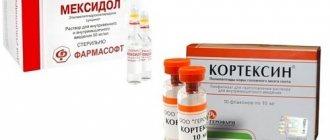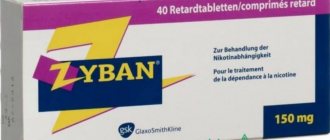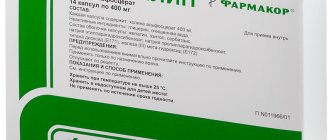pharmachologic effect
The tablets contain a medicinal substance that is a derivative of 1,4-benzodiazepine and has sedative , anticonvulsant and anxiolytic effects.
The action of the active substance is associated with the receptor complex. It includes gamma-aminobutyric acid, GAM-A receptor, benzodiazepine receptor and chloride channel. The active substance inhibits several structures in the central nervous system, in particular the spinal column, limbic system, cerebral cortex, hypothalamus and cerebellum. This substance has a strong anxiolytic effect, hypnotic and sedative activity, reduces the severity of seizures and the tone of skeletal muscles.
Relium in ampoules has hypnotic, anticonvulsant, sedative and anxiolytic effects. The action of the active substance is to influence GABA-A receptors and gamma-aminobutyric acid, which is an endogenous neurotransmitter involved in inhibition processes in the central nervous system. When using the solution, patients experience a decrease in seizures and slight relaxation of skeletal muscles. It also has some hypnotic effects.
Pharmacodynamics and pharmacokinetics
Bioavailability after oral administration is 98 percent. The maximum level of the active substance in the serum is observed after 0.9-1.3 hours and is 500 ng/ml. The main part of the active substance in the serum is in bound form. The half-life lasts up to two days. Diazepam penetrates the blood-brain and blood-placental barriers, and is also detected in small amounts in breast milk. Metabolization occurs in the liver and is excreted through the urinary system.
When administered by injection, high concentrations of the active substance are observed in amniotic and synovial fluids, as well as in breast milk. This substance tends to accumulate in adipose tissue and is subsequently released into the bloodstream. Approximately 25 percent is excreted unchanged.
Indications for use of Relium
Indications for use are as follows:
- neuroses , anxiety , restlessness , borderline states with manifestations of tension;
- tetanus , premature placental abruption, premature birth , facilitation of labor;
- premedication before anesthesia;
- status epilepticus;
- arthritis , bursitis , myositis , which are accompanied by tension in the skeletal muscles, spastic conditions that are associated with damage to the spinal cord and brain;
- withdrawal syndrome in chronic alcoholism, motor excitation of various etiologies in psychiatry and neurology, sleep disorders;
- cardioversion.
Oral tablets Relium (Relium)
Instructions for medical use of the drug
Description of pharmacological action
Interacts with benzodiazepine receptors in the brain, spinal cord, and cerebellum; and enhances the inhibitory effect of GABA on the central nervous system.
Indications for use
Neuroses, anxiety states, incl. for somatic diseases (cancer, heart failure, arterial hypertension, peptic ulcer of the stomach and duodenum); anxiety, sleep disorders, alcohol withdrawal, epilepsy, status epilepticus, muscle spasms of central origin, post-traumatic conditions and motor rehabilitation (to reduce skeletal muscle tension), tetanus, eclampsia, uncontrollable vomiting, premedication.
Release form
tablets, coated 5 mg; blister 20, cardboard pack 1;
Pharmacodynamics
A tranquilizer similar to a benzodiazepine. Reveals anxiolytic, sedative, anti-dominant, central muscle relaxant action. The mechanism of action associated with the enhancement of galmic influx of GABA into the central nervous system. The muscle relaxant action is also based on the inhibition of spinal reflexes. You may have an anticholinergic effect.
Pharmacokinetics
Wake up the shvidka. Cmax in plasma is measured after 90 minutes. Plasma protein binding is 98%. Penetrates through the placental barrier, near the spinal cord, and is seen in breast milk. Metabolized in the liver. Hit by nirks - 70%.
Use during pregnancy
Contraindicated (especially in the first trimester of pregnancy). During the period of treatment, take advantage of breastfeeding.
Contraindications for use
Hypersensitivity, disorders of the central gait, important mental insufficiency, confusion, impaired cognition, glaucoma, myasthenia, depression due to suicidal behavior, disorder of the nervous system.
Side effects
Drowsiness, fatigue, weakness, confusion, locomotor ataxia, weakened memory, decreased concentration and fluidity of reaction, decreased tone of skeletal muscles, decreased libido, hypotension I, bradycardia, collapse, impaired language, vision, confusion and disorientation , loss of speed, paradoxical reactions (psychomotor restlessness, seizures, anxiety, restlessness, sleeplessness, muscle tremors, aggressiveness), severe allergic reactions, after intravenous administration: thrombosis, phlebitis, symptoms Raynaud's sparrow.
Directions for use and doses
Tablets: daily, 5-20 mg per dose over a short period of time. Alcohol withdrawal syndrome: 10 mg 3 times per dose. If necessary, the dose can be increased to 60 mg/dose. Insomnia: 5-10 mg every day before bedtime, for a short period of time. Spasticity of muscles: 5-15 mg/double dose. If necessary, the dose can be increased to 60 mg. Children: 2-3 days - 2-5 mg / dose in 2-3 doses, 4-7 years - 4-6 mg in 2-3 doses, 8-18 years - 5-8 mg in 2 doses.
Overdose
Not described.
Interactions with other drugs
The effect is enhanced by antiepileptic, antihistamine, narcotic pain medications, neuroleptics, tricyclic antidepressants, sympatholytic and anticholinergic drugs, alcohol, muscle relaxants (d-tubocurarine etc.), weakening - nicotine. Cimetidine, disulfiram, isoniazid - prolong (increase elimination); rifampicin, phenobarbital - shorten the action (stimulate biotransformation).
Precautions for use
Cannot be administered parenterally in cases of shock, coma, acute alcohol withdrawal and after head injuries. In case of impaired liver function, dose reduction is absolutely necessary. For summer or debilitated illnesses, 1/2 of the original dose is recommended. Persons with advanced rhizomes should be taken with care to formulate medication, and special care should be taken with small children (possibly a disorder of the respiratory function). During the treatment period, and before 5 days after its completion, do not drive a car, service mechanical equipment, or drink alcohol.
Special instructions for use
Take special care in patients with cardiac and respiratory failure, organic changes in the brain (in such cases, it is recommended to avoid parenteral administration of diazepam), with closed-cuta glaucoma and pre-clinical glaucoma , with myasthenia. Particular care is required when taking diazepam, especially during treatment, in patients who have been taking centrally administered antihypertensive drugs, beta-blockers, anticoagulants, and cardiac glycosides. When changing therapy, the dose should be changed step by step. When administered with a diazepam after a period of severe congestion, you may experience restlessness, restlessness, tremor, and seizures. Diazepam should be discontinued if paradoxical reactions develop (excitement, anxiety, sleep disturbance and hallucinations). After intramuscular injection of diazepam, there may be an increase in the activity of CPK in the blood plasma (which can be observed in the differential diagnosis of myocardial infarction). Unique in / a introduction. During the feast period, do not allow alcohol to take hold. By introducing Diazepam to the building before water transport and water treatment mechanisms, Diazepam can result in increased fluidity of psychomotor reactions, which should be used to protect patients who are engaged in potentially unsafe types of activities. i.
Storage conditions
In a dry, protected place in a light place, at a temperature below 25 ° C.
Best before date
36 months
ATX classification:
N Nervous system
N05 Psycholeptics
N05B Anxiolytics
N05BA Benzodiazepine derivatives
N05BA01 Diazepam
Side effects
When using Relium, drowsiness, muscle weakness and fatigue are often observed, which spontaneously disappear after a couple of days. Other unwanted effects may also occur:
- allergic reactions: anaphylactic reactions, rash , itching and urticaria ;
- drug addiction;
- ECG changes, hyperhidrosis , convulsions , pain in joints, bones and muscles, increased risk of fractures, respiratory failure , liver dysfunction, increased activity of liver enzymes, jaundice , urinary incontinence or retention;
- bowel disturbances, nausea , colic , dry mouth or hypersalivation , vomiting , anorexia ;
- decreased visual acuity, vertigo , diplopia ;
- changes in blood composition, neutropenia ;
- confusion , emotional poverty, depression , decreased attention, deviant behavior , nightmares , psychosis , hostility, irritability , anxiety , hallucinations , agitation ;
- anterograde amnesia (with high doses of diazepam), anger, aggression , disorientation , dizziness , speech , tremor , headache , mood lability, loss of consciousness , dysarthria ;
- heart failure (up to cardiac arrest), arterial hypotension , bradycardia , circulatory failure, chest pain.
Instructions for use of Relium (Method and dosage)
According to the instructions for use of Relium, tablets are taken regardless of food, the dose is selected individually for each patient.
As a rule, in most cases for anxiety conditions, 1 tablet per day is prescribed. The maximum dose is 30 milligrams per day. For spastic conditions, 5 to 15 milligrams per day are prescribed. The maximum dose is 60 milligrams per day. For insomnia associated with anxiety, 5 to 15 milligrams are prescribed. It is recommended to take the medicine 20-30 minutes before bedtime. For premedication , 5 to 20 milligrams of diazepam .
During therapy, it is recommended to use only the minimum doses of the active substance that provide a therapeutic effect (the dose can be increased only in cases where there is a significant need to enhance the effect). It is not advisable to use the full dose more than four times a week.
The maximum duration of treatment is one month, for anxiety conditions - from 8 to 12 weeks (the time for drug withdrawal is included in the periods).
The solution is administered intravenously or intramuscularly. Injections can be done no more often than every 3-4 hours, in extremely severe cases they can be done every hour. The drug must be injected into a vein very slowly, otherwise collapse . Patients over 65 years of age, as well as weakened patients, can be prescribed only minimal doses.
The solution can be administered intravenously only into large veins; intraarterial administration is unacceptable. It can be administered intramuscularly only into large muscles. This medicine can only be administered separately, as it is incompatible with other medicines.
Similar drugs:
- Neurotropin (neurotrophin) Solution for injection
- Magnesium sulfate Powder for oral suspension
- Magnesium sulfate Substance-powder
- Celandine grass (Chelidonii majoris herba) Vegetable raw materials
- Xanax Oral tablets
- Rivotril Oral tablets
- Neurox Solution for intravenous and intramuscular administration
- Tebantin Capsule
- Phenazepam Solution for intravenous and intramuscular administration
- Benzonal Oral tablets
** The Drug Directory is intended for informational purposes only. For more complete information, please refer to the manufacturer's instructions. Do not self-medicate; Before starting to use the drug Relium, you should consult a doctor. EUROLAB is not responsible for the consequences caused by the use of information posted on the portal. Any information on the site does not replace medical advice and cannot serve as a guarantee of the positive effect of the drug.
Are you interested in the drug Relium? Do you want to know more detailed information or do you need a doctor's examination? Or do you need an inspection? You can make an appointment with a doctor - the Euro lab is always at your service! The best doctors will examine you, advise you, provide the necessary assistance and make a diagnosis. You can also call a doctor at home . Euro lab clinic is open for you around the clock.
** Attention! The information presented in this medication guide is intended for medical professionals and should not be used as a basis for self-medication. The description of the drug Relium is provided for informational purposes only and is not intended for prescribing treatment without the participation of a doctor. Patients need to consult a specialist!
If you are interested in any other drugs and medications, their descriptions and instructions for use, information about the composition and form of release, indications for use and side effects, methods of use, prices and reviews of drugs, or you have any other questions and suggestions - write to us, we will definitely try to help you.
Overdose
In case of overdose, dysarthria , nystagmus , drowsiness and ataxia . apnea , coma , depression of cardiac and vascular function, and arterial hypotension can also sometimes be observed . In people with diseases of the respiratory system, with an overdose, respiratory depression becomes more pronounced.
Treatment consists of eliminating symptoms, supportive therapy (carrying out artificial respiration (in the absence of consciousness), monitoring the functions of the cardiovascular, nervous and respiratory systems). To reduce the absorption of diazepam, enterosorbents are prescribed (gastric lavage is not recommended).
Possible side effects and overdose
No matter how ideally the treatment regimen is selected, there is a risk of unwanted symptoms. The most common side effects are:
- from the central nervous system - headache, dizziness, pressure in the temporal region or the back of the head, disturbances in orientation in space, dyslalia;
- from the digestive tract - nausea, vomiting, constipation, diarrhea, epigastric pain, increased gas formation, yellowness of the skin;
- from the cardiovascular system – arterial hypotension;
- dermatological problems – itching, rash, dermatitis;
- the occurrence of paradoxical reactions - hallucinations, delirium, increased tone, insomnia (such symptoms are a direct indication for discontinuation of the medication).
Symptoms of a drug overdose are:
- excessive sleepiness;
- weakness;
- disturbance of consciousness;
- decreased reflexes;
- apnea;
- coma.
When the first signs of an overdose appear, the patient should be given immediate assistance, following the following algorithm:
- Stop taking the drug.
- Give the person a comfortable position.
- Rinse the stomach with plenty of distilled water.
- Give any sorbent (white carbon, activated carbon).
- While providing assistance, be sure to monitor your pulse, blood pressure, and respiration.
- Call an ambulance (if signs appear at home), which will provide venous access for adequate infusion therapy.
- Use a specific antidote - flumazenil (with its use there is a high risk of seizures).
Interaction
Concomitant use with drugs that depress the central nervous system (including opioid analgesics , hypnotics , sedatives , antipsychotics and anesthetics respiratory center, and also contributes to the development of severe arterial hypotension .
Simultaneous use with ethanol or drugs containing ethanol enhances the inhibitory effect on the central nervous system (especially the respiratory center) and contributes to the development of pathological intoxication syndrome.
Concomitant use with disulfiram , omeprazole , cimetidine increases the intensity and duration of exposure to diazepam.
Concomitant use with fluvoxamine increases plasma concentrations and side effects of diazepam.
Phenytoin and phenobarbital accelerate the metabolism of diazepam, and rifampicin increases its elimination. Paracetamol reduces the excretion of diazepam, and simultaneous use with risperidone promotes the development of NMS.
Simultaneous use with metoprolol leads to a deterioration of psychomotor reactions and a decrease in visual acuity, with lithium carbonate - leads to the development of a coma, with levodopa - suppresses the antiparkinsonian effect, with clozapine - causes loss of consciousness, respiratory depression and severe arterial hypotension, with diclofenac - causes increased dizziness, with bupivacaine - increases its concentration in the blood plasma, with oral contraceptives - enhances the effect of diazepam and can lead to breakthrough bleeding , with muscle relaxants - enhances their effect and increases the risk of apnea , with tricyclic antidepressants (including amitriptyline ) - enhances a depressant effect on the central nervous system, enhances the cholinergic effect and increases the concentration of antidepressants.
Simultaneous use with caffeine reduces the sedative and anxiolytic effects of the drug. Medicines that cause induction of liver enzymes, including anti- epileptic ( phenytoin , carbamazepine ), accelerate the elimination of diazepam.
In people who have been taking cardiac glycosides , anticoagulants , beta-blockers , and antihypertensive drugs , the mechanisms and extent of drug interactions may be unpredictable.
Interaction with other drugs and special instructions
Relium should be used with extreme caution simultaneously with phenothiazine derivatives, narcotic analgesics, hypnotics and antidepressants. Such combinations enhance the effect of the main component of Relium - diazepam.
It is prohibited to consume alcohol and drugs during treatment with Relium, since in such a situation the nervous system is significantly depressed and a syndrome of pathological intoxication occurs, which does not depend on the amount of alcohol consumed. This condition is quite often fatal.
Oral contraceptives (COCs) inhibit the effect of the medication. The process of smoking during the treatment period has the same effect.
Concomitant use with other drugs does not cause significant changes in the pharmacodynamics of Relium. However, clinical trials on this matter are ongoing.
Any treatment with this drug should be carried out under the strict supervision of medical personnel. It is prescribed with caution for the treatment of depressive disorders, since there is a high probability of suicidal tendencies in the patient’s behavior.
Clinical and laboratory parameters of the blood and urine system should be monitored periodically during therapy. Particular attention should be paid to changes in liver function tests. The drug is withdrawn gradually.
Analogs
Level 4 ATC code matches:
Bromazepam
Helex
Rudotel
Nozepam
Tazepam
Xanax
Elenium
Valium Roche
Alprazolam
Tofisopam
Diazepam
Grandaxin
Mezapam
Sibazon
Seduxen
Relanium
Lorazepam
Analogues are:
- Apaurin;
- Seduxen;
- Diazepam;
- Relanium;
- Valium.








